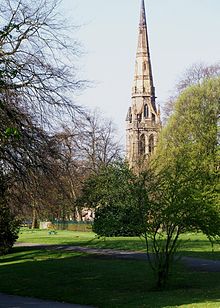Holy Trinity Platt Church
| Holy Trinity Platt Church | ||
|---|---|---|
| Holy Trinity Church, Rusholme | ||
Style Gothic Revival | | |
| Groundbreaking | 1845 | |
| Completed | 1912 | |
| Specifications | ||
| Spire height | 170 feet (52 m) | |
| Materials | Terracotta, slate roof | |
| Administration | ||
| Province | York | |
| Diocese | Manchester | |
| Archdeaconry | Manchester | |
| Deanery | Hulme | |
| Parish | Holy Trinity at Rusholme | |
| Clergy | ||
| Rector | Rev Dr Paul Mathole | |
| Laity | ||
| Reader(s) | David Poole Isabel Turley | |
Holy Trinity Platt Church (also known as Holy Trinity Church, Rusholme), is in
History

The church was built in 1845–46 to a design by the
Sharpe's first "pot church" had been
Architecture
Exterior
Terracotta is used as the facing material for both the interior and the exterior of the church.
Interior
Internally, terracotta is used even for the piers of the arcades. The font is in stone and has an octagonal bowl. The stained glass in the chancel forms a memorial to the Worsley family and dates from 1849 to 1850. In the north aisle is a window dated 1871 with glass made by Lavers, Barraud and Westlake.[3]
See also

- List of architectural works by Edmund Sharpe
- Grade II* listed buildings in Greater Manchester
- Listed buildings in Manchester-M14
References
- ^ Holy Trinity Platt, Manchester, Church of England, retrieved 18 June 2010
- ^ a b c d Historic England. "Church of Holy Trinity, Platt Lane, Manchester (1246948)". National Heritage List for England. Retrieved 29 May 2012.
- ^ ISBN 0-300-10583-5
- ^ UK Retail Price Index inflation figures are based on data from Clark, Gregory (2017). "The Annual RPI and Average Earnings for Britain, 1209 to Present (New Series)". MeasuringWorth. Retrieved 11 June 2022.
- ISBN 978-1-84802-049-8
- ^ a b Hughes, John M. (2010), Edmund Sharpe: Man of Lancaster, John M. Hughes, pp. 258–270
